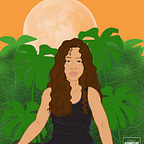A Culture Between Life and Death
My cultural identity stems from the traditions of story telling, tools of song and dance to make sense of heart and mind, and of rituals of cleaning to keep communion with God, to cleanse the soul of sadness.
As I grow my identity acquires new dimensions or rather my self-understanding deepens as my perception of the personal and collective history of my people widens. When I think about my life experience I’m able to connect it to the collective experiences of my family and of impoverished communities of color. To think about the identity of any culture one is prompted to consider that culture’s creation story.
Of my own birth, my mother said it felt like her hips were breaking but it was my collarbone that was broken. I was too wide and my head too big for my mother, a 16-year-old girl to bear, so the doctor broke my clavicle to keep my umbilical could from suffocating me. I also had a hole in my heart that apparently closed on its own.
So to be alive I had to be broken. Since then my mom has always been wary of her mother-in-law for yelling, “cut her more!”
I benefit from the research of scientists such as Vincent Felitti, in that I am able to reflect further on my newborn heart, now reading this hole as a physical symptom of the emotional pain from my mother and her mother and her mother. The emotional and physical trauma of their lives is literally transcribed on their DNA and passed on to me. I realize it’s up to me to heal for my family, for our future.
At age three I came close to death again when I was in a car accident with mom, leaving me with a broken right leg and scar on my head. On that same right leg is a scar reminding me of the time a nail tore into me as I was trying to climb a brick wall a few years later. I read the scar as a heart, an arrowhead that ties me to this land.
The scars on my body are literal and symbolic representations of the trauma my family has endured, scars on the bodies that become stronger with each re-membering.
This is culture of my people, the ones who use trauma and violence as fertilizer for hope, healing, and safety.
The body does not forget its history and to seek justice, as an educator, as a son, as a human seeking self-actualization, is to address the trauma my students might experience or have already endured. I realize now, we need to confront familial pain, past trauma directly and delicately. To address the pain in a way that offers healing, promotes resiliency, and gives opportunity to rewrite the harmful impacts of childhood adversity so that when they remember themselves they realize their strength and beauty.
In my path of decolonization I have had to reclaim a relationship to the natural environment, restart my relationship with food, and return to prayer and ritual to reconnect with my soul. This work requires relationships, it requires returning from alienation and isolation. This is difficult for me because while I long for deep communion with the soul, with the God in others, I must also beware of the real risks that come with relationships and interaction. Initially, I am on guard looking for all the parts of people that could hurt me and I establish limits for protecting what is sacred within me. I worry that this is interpreted as searching for the worst in people and so I must maneuver more carefully while searching for ways to transcend division.
In fact I know that when I deal with such depth of emotion, it can unsettle others, causing them to confront the pain long buried, the unhealthy, unhappy ways of being with each other that they’ve long grown accustomed to. But still I must continue.
However, my work with students at home and my experience as one of those students, gives me visceral knowledge of the reality of a struggle for life over death. I know the pain of losing a student to senseless violence. I grew up learning how to carefully navigate cemeteries, finding my way to family member after family member memorialized.
At 23 I hoped to find healing by being the support to my students that I lacked, knowing I could not proclaim to have dealt with the repercussions of the trauma I’ve endured in my life.
Giving my all to my students, while being still suffering from depression, isolation, and being unable to financially sustain myself educating, I resolved to get at the root.
I came home.
